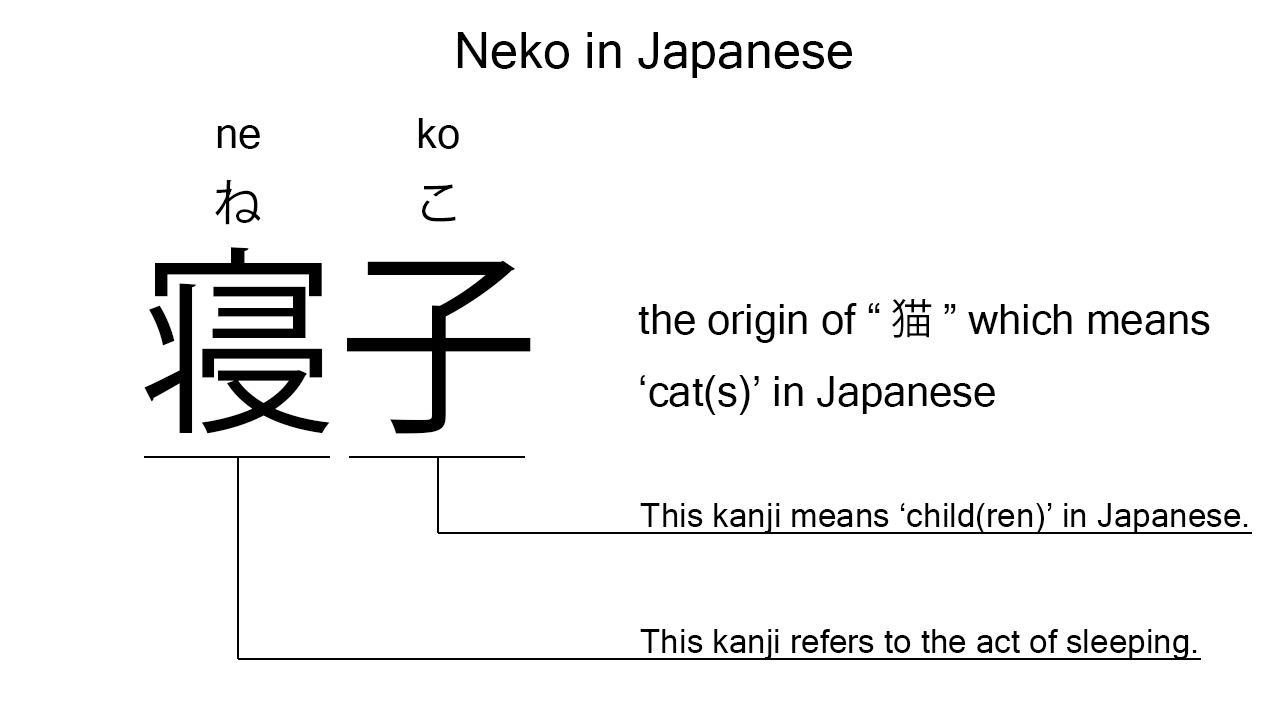What does “neko” mean in Japanese?
Native speakers use neko to mean a ‘cat’ in Japanese. Perhaps, some Japanese learners know this word as it is sometimes used in Japanese movies, songs, novels, manga, anime, and the like. In this blog post, however, I’m explaining this word in detail together with its origin. And also, I’m explaining how to use it through example sentences. My explanations would help Japanese learners understand neko more clearly. Then, let’s get started!
Contents
Definition and meaning of “neko”
Let me start with the definition and meaning of neko.
- neko – 猫 (ねこ) : a noun meaning a ‘cat’ in Japanese. This can also work as plural. Learn more about Japanese plural.
The definition and meaning are simple and clear. To understand this noun more clearly, however, let me explain its original kanji expression in detail.
Neko in kanji
Neko originally consists of the following two parts:
- ne – 寝 (ね) : a word often used to refer to the act of sleeping in Japanese.
- ko – 子 (こ) : a word widely used to mean a ‘kid’ or ‘child’ in Japanese.
From these two parts, we can understand that the formed noun literally means a ‘sleeping child’ in Japanese. This literal interpretation is not completely in line with the actual meaning, but still a good metaphor for cats’ lives. Indeed, they sleep all the time like babies.

When we meet new kanji expressions, we should check their origins in detail to understand their meanings clearly and deeply. In many cases, original expressions tell us a lot about the meanings of the current ones. Actually, here, we could get the better understanding of neko through the detailed check above.
So far, I’ve explained the definition and meaning of neko together with its origin. Then, let me explain how to use it through the example sentences below.
How to say “cat” in Japanese
kono neko wa totemo kawaii – この猫はとても可愛い (このねこはとてもかわいい)
This cat is very cute.
Below are the new words used in the example sentence.
- kono – この : a determiner used before a noun which refers to something close to the speaker. In the example, this is used before neko to mean ‘this cat’ in Japanese.
- wa – は : a binding particle working as a case marker or topic marker. In the example, this works after kono neko to make the subject in the sentence.
- totemo – とても : an adverb of degree meaning ‘very’, ‘much’, ‘so’, or such in Japanese. In the example, this works in front of kawaii to emphasize its meaning.
- kawaii – 可愛い (かわいい) : an i-adjective meaning ‘cute’ in Japanese.
This is a typical usage of neko. In this example, it works together with the determiner, kono, to mean ‘this cat’ in Japanese.
Another example of “neko”
boku wa neko ga suki desu – 僕は猫が好きです (ぼくはねこがすきです)
I love cats.
Below are the new words used in the example sentence.
- boku – 僕 (ぼく) : a pronoun meaning ‘I’ in Japanese. This is used mainly by boys and young males.
- ga – が : a case particle used to make the subject word or the object word in a sentence. In the example, this is used after neko to make the object in the sentence.
- suki – 好き (すき) : the stem part of the na-adjective, sukina, which means ‘favorite’ in Japanese. Native speakers, however, often use this as an individual word to mean ‘to like’ or ‘to love’ in Japanese. In the example, this is used to mean ‘to love’ in Japanese.
- desu – です : an auxiliary verb used after a noun or adjective to make it polite. Probably, this is well known as a part of the Japanese desu form. In the example, this is used after suki to make it sound polite.
This is another example of neko. In this example, it works as plural to mean ‘cats’ in Japanese. When we want to mean a ‘cat’ or ‘cats’ in Japanese, anyway, this noun is always a very good option.
Summary
In this blog post, I’ve explained the definition and meaning of neko in detail together with its origin. And also, I’ve explained how to use it through the example sentences. Let me summarize them as follows.
- neko – 猫 (ねこ) : a noun meaning a ‘cat’ in Japanese. This can also work as plural. This noun originally consists of the following two parts: ne and ko. The first one is a word often used to refer to the act of sleeping; the second is a word which means a ‘kid’ or ‘child’ in Japanese. So, the formed noun literally means a ‘sleeping child’ in Japanese. This literal interpretation is not completely in line with the actual meaning, but still a good metaphor for cats’ lives. Indeed, they sleep all the time like babies. When we want to mean a ‘cat’ or ‘cats’ in Japanese, anyway, this noun is always a very good option.
Hope my explanations are understandable and helpful for Japanese learners.
Leave a Reply